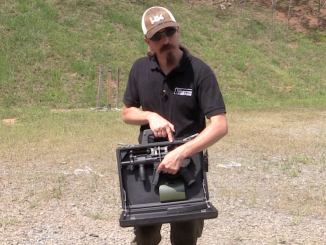Mauser had been at the forefront of military self-loading pistol design with its C96 pistol, but by the 1930s it had lost major market share to Sauer and Walther in police and commercial guns. The Mauser 1910/1914/1934 line of compact pistols was getting a bit old, and the Sauer 38H and Walther PP/PPK were very popular. Mauser want to produce a new offering, and they tasked a very young (25 at the beginning of the project) engineer named Alex Seidel with it. Seidel would go on to be one of the founding partners of Heckler & Koch, and his work on the HSc would heavily influence the HK4 pistol several decades later.
The HSc was carefully designed to avoid infringing on other patents, particularly Walther’s. It was a double action, blowback system chambered for .32 ACP (and later .380). The initial guns were ready in 1938, but it took until 1940 to secure government permission to put them into production. Once available, they were sold to the German Army, Navy, various police forces, and on the commercial market – with a total of about 272,000 made by the end of the war (including about 15,000 made under French occupation of the Mauser factory complex).
Today, we will be looking at a preproduction prototype, early low-screw model, standard early and late war production (to exhibit the decline in finish quality as the war progressed), and a 1942 stamped slide experimental version that would inform later Volkspistole designs.




Great designs can run and influence other designs for a long time. The Colt 1911, as a counterpart, needs no explanation. I could be wrong.
I would say that is not surprising that one man tasked with creating automatic pistol for similar purposes as his earlier successful design would repeat solutions.
“French occupation of Mauser” . Oh oh, my knowledge of French occupation of anything besides Vietnam is sorely lacking. I’ll have to crack the books.. Thanks.
It’s fascinating how your interest in a particular firearm can come from the casual mention of that gun in a book. The first time I encountered a Mauser HSC was in Ice Station Zebra which I read in the mid 60s at age 13 or 14. I thought that I knew a little about firearms from watching westerns and Combat on TV and I knew that Mauser made rifles but that was about it. In those far off days my only source of good information on guns was the copy of Small Arms of the World in the public library. I looked the HSC up and came to the conclusion that it was one of the coolest looking small pistols out there. When you’re around 13 years old that’s about all you have to work with. The HSC went on my “I’d like to own one list” and it’s still there 50+ years later because you almost never see one for sale. There were a fairly good number made but maybe they just didn’t come into the U.S. in large numbers or the guys who own one are waiting for another encounter with Russian bad guys at the
top of the world.
Here is a broad variety of them for sale: https://www.gunbroker.com/All/search?Keywords=mauser%20hsc
Looks like complete wartime specimens go for well over $600
If your to buy list is open for submissions then I suggest adding Mauser WTP II
https://unblinkingeye.com/Guns/MP-III/mp-iii.html
Dear Dave Lewis: You’re sure it wasn’t “Funeral in Berlin” you read? Johnnie Vulkan had an HSc. The narrator’s gun in “Ice Station Zebra” was a 6.35 Mannlicher-Schoenauer (Alistair MacLean having a fondness for little guns — several of his novels featured 4.25 Lilliputs!) Not sure what Patrick McGoohan carried in the movie. They are rare because the WWII ones have been swallowed by collectors and the post-war civilian imports didn’t quite take off in competition (again) with the Walther PP and PPK.
Meanwhile, I must disagree that the commercial demand came down to hammer vs. striker. The preference became double-action hammer down on a loaded chamber vs. single action striker carried with empty chamber, or carried cocked and locked. The Walther PP and PPK led the way in safe double-action carry, followed by P38, HSc, and Sauer 38H. However, I’d like to know how you safely lowered a hammer on a chambered HSc once Walther won their patent fight — what a tiny little hammer spur and no way to put your finger on the back of the firing pin!
“(…)very young (25 at the beginning of the project) engineer named Alex Seidel(…)”
According to query in Wikipedia: https://de.wikipedia.org/wiki/Alex_Seidel
he was son of Paul Seidel who was Obermeister [I do not know English translation of this work] at MAUSER AG. Also it states that he worked at Mauser since 1932 as Gruppenleiter für den Sektor Entwicklung Pistolen till the end of WWII.
So it seems it was one of his first works.
I.Ya.Stechkin (1922-2001) also developed his successful weapon – namely APS – early in his career – 1948 (in production since 1951), although strictly speaking it was not his first design – see TС: http://sof-mag.ru/sof_2002/gal_2002_03.html
“The fuse located on the shutter-cover, by analogy with the Sauer, Walter, and other pistols, was preferable. When a pistol with a cocked trigger was fused, the latter should automatically be reset from the combat cock.”
That Sof website (Is that a magazine I.e. A paper publication over there, we used to have one similar here in the 90’s; Combat and Survival) is awesome, and it would provide hours of fun with Google translate for English readers.
Well worth checking out, check this:
The vehicle gun does not have screw mounts. Винтовых креплений пистолет ТС не имеет. Think it is that part by working out; part 4 then counting the full stops. See, hours of fun, he he.
Add that DRPK pistols safety position and we are in buisness with this pistols feature in .44 Special, what?
I like all this guns features, fuck walter, pop a sideways mounted gas delay thing on it and fiddle around till you can get that Dprk safety thing “on a similar looking pistol” to double as the disassembly method, make it in .44 Special with a nicked magazine design from someone who made an auto with a rimmed cartridge, make it in Brazil and sell it in the U.S for 400 bucks as the Fauser Fatboy.
Thats how you make a gun; who wants to crowd fund me he he.
Looks a bit Star Wars to me, zap.
It is always surprises me, when I hear about Nazi patent arguments; its like they absolutely belived they were not off to Valhalla anytime soon. 1942 and they are arguing about patents… Its clearly going pearshaped snap out of it.
Even funnier how the different war factions respected each others patents while sending their troops to kill each other. Doesn’t go to my head.
That was typical of German industry, no matter which industry you’re talking about. Here’s an example from the liquid rocket propellant side of their chemical and aviation industries, re the development of hypergolic fuel/oxidizer combinations;
– Clark, Dr. John D. Ignition!; An Informal History of Liquid Rocket Propellants. New York; Rutgers Univ. Press, 1971. Chapter 2, “Peenemunde and JPL”, P.16.
So it wasn’t just the arms industry. It was an effect of German patent law, which was a lot more liberal on what actually could be patented than just about anybody else’s.
cheers
eon
“(…)Nazi patent arguments; its like they absolutely belived they were not off to Valhalla anytime soon. 1942 and they are arguing about patents…(…)”
What I could say? Ordnung muß sein.
That being said, keep in mind that after Great War ended Bergmann company transfer know-how for production of theirs MP 18 to SIG (Switzerland) to go around Versailles Treaty limitation, which start making: https://guns.fandom.com/wiki/SIG_M1920 as these include some solutions protected by patents assigned to Hugo Schmeisser he should get some money. But he did not, so he go away from Bergmann after several years of work:
https://de.wikipedia.org/wiki/Hugo_Schmeisser#Weimarer_Republik
result of this experience was that Schmeisser later make sure that SYSTEM SCHMEISSER or similar words will be placed at products designed by him.
Off topic, but if you had… Say a over and under shotgun, type… Shotgun “bare with me” right, but the bottom barrel was say; further away from the other than now.
Ok! With a gap between them. If you fired the upper it would recoil; muzzle climb etc, but if it fired the bottom one (automatically) just after “split seconds” and you had a gas vent on the top of the lower barrel at say 1/4 the length of the barrel, would it bring the top one down via muzzle blast before the sabot left that barrel… A bit even, thus when the sabot left the bottom barrel it would be more level, and the top may be slightly more.
Just thinking about this really:
https://www.shootinguk.co.uk/reviews/rifle/baikal-mp-221-45-70-double-rifle-review
Barrel regulation is it? This has like a wheel to adjust, which is good, and I know I am firing two shots, but if you have a double rifle; your wanting two shots quick aren’t you.
Maybe not in .577 whatever, but in 45/70… Auto double thing; less powerfull than .577 etc, but better via 2.
Legality aside, one pull of the trigger etc.
Or maybe just the bottom barrel would be more level than it would be, after usually, after firing the top… Imagining the top had a upward facing brake, so bang!.bang! bottom gas leak.top muzzle brake activated.bottom round leaves.
Something like that.
http://www.predatormastersforums.com/baikal.html That shows a Baikal drilling in essence, an Izh-94. Base it on that maybe.
Not sure it will work mind, he he; might… Need to fire almost at the same time for sure… quicker than you pulling the trigger.
Specialist body armour “popper” simpler An94, albeit with less shots… Mind you if it worked; you wouldn’t need to waste ammo, as it would have worked.
Language tip:
Alex Seidel’s family name is not emphasized on the second syllable, like Wendell, but like the name of the character Mendel in the George Smiley movies.
Volkspistole is pronounced as if it started with an F. In German a leading V may be pronounced two ways, mostly like F (Vater as in father) but sometimes in the way Germans pronounce a W (Vase, the same as English vase).
I hope anybody gets to this message, although it is after Pdb’s plenty, but a little difficult to follow contributions.
FARTER. There you are; an attenion grabbing comment to draw folks to your undoubtedly interesting comment, from “mine” right well I’ll just be quiet, herumf.
My 9… Ok I see what you mean, sorry I do have a tendency to that. 10 now, ooops. Its not on purpose, I just kinda rattle off thoughts; I do it in emails everything. I can only apologise.
It’s a little strange that Ian did not mention the brake groove in the chamber as the most interesting technical moment…
Or am I missing something?..
How are the location of the screws and the finish changed, perhaps interesting for auction hucksters…
But Ian’s reviews are primarily interesting by his attention to technical details…
There used to be…
Or is it already in the past, and now Ian decided to focus on effective management? 😉
Stiven,
cold it be you think of the HK4 in 9 mm Browning short, also designed by Alex Seidel? My relatively early HSc in 7.65 mm has no “brake groove”.
“(…)brake groove in the chamber(…)”
Would presence of this feature mean that fired cases have deformation as seen on 2nd image from top here: https://unblinkingeye.com/Guns/Mann/mann.html
?
And yes, the way Ian constantly waves the camera around the subject… not that much of a hindrance… but a little annoying.
He has neat and compact palms, but the rollers are not looking for his palms. 😉
Perhaps You should “read something about” the rules for conducting detailed shooting of objects? If not for criminologists, then at least for museum staff…
“cold it be you think of the HK4 in 9 mm Browning short, also designed by Alex Seidel? My relatively early HSc in 7.65 mm has no “brake groove””(C)
There should not be a groove in .32. It was added in 380, since the HSc had a too light slide.
This groove is mentioned from time to time in various sources, but not in noteworthy. And only versions in .32 fell into my hands…